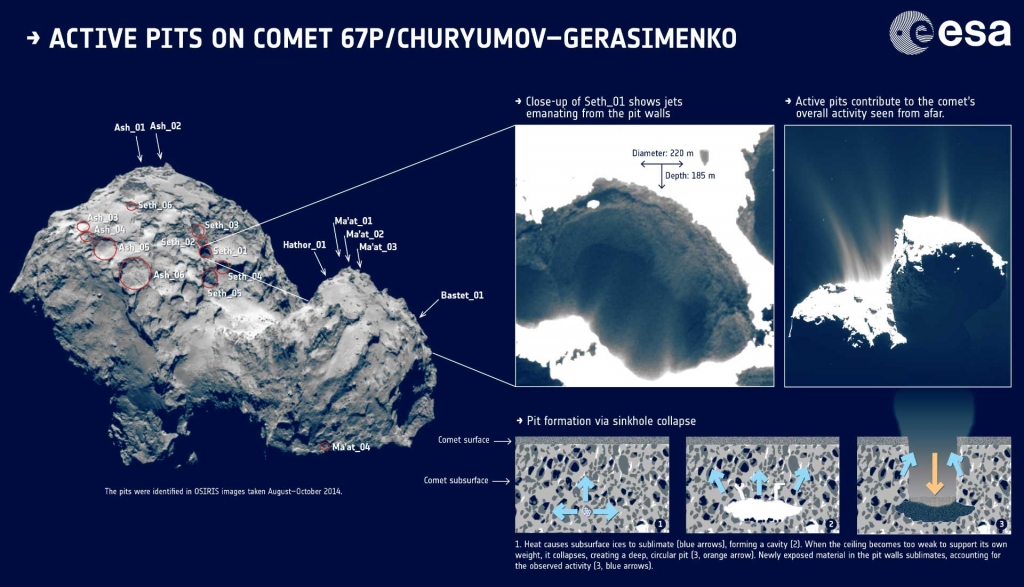-
Tips for becoming a good boxer - November 6, 2020
-
7 expert tips for making your hens night a memorable one - November 6, 2020
-
5 reasons to host your Christmas party on a cruise boat - November 6, 2020
-
What to do when you’re charged with a crime - November 6, 2020
-
Should you get one or multiple dogs? Here’s all you need to know - November 3, 2020
-
A Guide: How to Build Your Very Own Magic Mirror - February 14, 2019
-
Our Top Inspirational Baseball Stars - November 24, 2018
-
Five Tech Tools That Will Help You Turn Your Blog into a Business - November 24, 2018
-
How to Indulge on Vacation without Expanding Your Waist - November 9, 2018
-
5 Strategies for Businesses to Appeal to Today’s Increasingly Mobile-Crazed Customers - November 9, 2018
Mystery sinkholes found on comet
These images were sent by European Space Agency’s Rosetta spacecraft. Scientists assert that they are observing newly formed sinkholes on 67P, several of which are now ejecting jets of dust, according to lead researcher Jean-Baptiste Vincent, who is associated with the Max Planck Institute for Solar System Research. Middle, top: close-up of the active pit named Seth_01 reveals small jets emanating from the interior walls of the pit. The new observations and analysis were released Wednesday, July 1, 2015 by the journal Nature. The Rosetta spacecraft’s images of the comet suggest that the round pits on its surface form as sinkholes. Much like planets and moons, there’s more to these cosmic projectiles than meets the eye. Nor can eruptions explain them, because estimates of the amount of stuff exhumed by outbursts from the nucleus (based on what Rosetta has detected) suggest such plumes only contain a thousandth as much material as a typical large, active pit would have expelled.
Advertisement
Stuff underground could sublimate: heat conducted to subsurface ices such as carbon dioxide could cause these volatile ices to sublimate, even though they’re not directly exposed to sunlight, and thereby create a cavity underground.
This process contributes largely to the craggy, duck shape of the comet and the pits may also allow scientists to understand more about the fundamental structure of it. Mission researchers have previously noted ‘goosebumps’ on the comet that are 1-3 metres and could be original icy building blocks that formed the comet 4.5 billion years ago.
“The sinkholes on 67P are very large, two football fields next to each other and deeper than the Washington monument”, Dennis Bodewits, one of the authors of the study and an assistant research scientist of astronomy at the University of Maryland, told Business Insider in an email.
In a study published to Nature, the team has found 18 quasi-circular pits just in the northern hemisphere of the comet, all measuring from a few tens to a few hundreds of metres in depth (up to 210m) to a smooth, dust-covered sinkhole floor. And there are pits with deep, almost vertical walls, which create empty cylinders in the ground. These deeper pits are therefore thought to be relatively young. On April 30, 2014, one such event was observed by Rosetta as it approached the comet.
Advertisement
Another pit that might be a sinkhole on 67P as seen by Rosetta. After surface layers fall, a big, deep, circular pit is left for us to ogle, thanks to the sinkhole and Rosetta’s OSIRIS. Scientists believe that this gas emission that includes dust and other particles occur all around the comet however these new findings show that this material that causes Comet 67/P’s tail, apparently originate from sinkholes. “It seems that outbursts aren’t driving the process, but instead are one of the consequences”. As it widens and deepens, the loss of material makes the ceiling too thin to support its own weight, and collapses. “And with the extension of the mission until September 2016, we can do the best job possible at unravelling how comets work” says Matt Taylor.




























